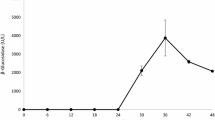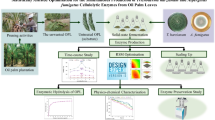Abstract
Flourensia cernua foliage was used in a solid-state fungal bioprocess to identify factors that could affect β-glucosidase production such as growth medium components and partial identification of molecules from the plant material. Under an exploratory experimental design, each variable had their distinctive result on conditions, which affects and could further improve β-glucosidase production. Under the experimental design, 1482 U/L of β-glucosidase were detected, which marks an improvement in production compared to levels obtained in a control treatment with an activity of 1092 U/L. It was shown that inoculum, water content and pH were the factors with the greater effect on β-glucosidase production. Polyphenolic content and cellulosic fiber in the form of raw fiber were measured to assess compound degradation of the plant material. Although fiber content was apparently unaffected, polyphenolic content decreased; β-glucosidase was produced by A. niger GH1. This behavior could be associated with fiber level and polyphenolic content because molecules of this type can be hydrolyzed by β-glucosidase. According to our results, F. cernua biomass can be used as a carbon source for β-glucosidase production in a short culture time.



Similar content being viewed by others
References
Aguilera-Carbo A, Augur C, Prado-Barragan LA, Favela-Torres E, Aguilar CN (2008) Microbial production of ellagic acid and biodegradation of ellagitannins. Appl Microbiol Biotechnol 78:189–199
AOAC (1990) Official methods of analysis of the AOAC, 15th edition. Method 962.09
Ascacio-Valdés JA, Buenrostro J, De la Cruz R, Sepúlveda L, Aguilera A, Prado A, Contreras J, Rodríguez R, Aguilar CN (2014) Fungal biodegradation of pomegranate ellagitannins. J Basic Microb 58:28–34
Ascacio-Valdés JA, Aguilera-Carbó AF, Buenrostro J, Prado-Barragán A, Rodríguez-Herrera R, Aguilar CN (2016) The complete biodegradation pathway of ellagitannins by Aspergillus niger in solid-state fermentation. J Basic Microb 56:329–336
Buenrostro-Figueroa J, Velázquez M, Flores-Ortega O, Ascacio-Valdés J, Huerta-Ochoa S, Aguilar C, Prado-Barragán A (2017) Solid state fermentation of fig (Ficus carica L.) by-products using fungi to obtain phenolic compounds with antioxidant activity and qualitative evaluation of phenolics obtained. Process Biochem. doi:10.1016/j.procbio.2017.07.016
Castro AM, Castilho LR, Freire D (2015) Performance of a fixed-bed solid-state fermentation bioreactor with forced aeration for the production of hydrolases by Aspergillus awamori. Biochem Eng J 93:303–308
De León-Zapata MA, Sáenz-Galindo A, Rojas-Molina R, Rodríguez-Herrera R, Jasso-Cantú D, Aguilar CN (2015) Edible candelilla wax coating with fermented extract of tarbush improves the shelf life and quality of apples. Food Packag Shelf Life 3:70–75
Dey T, Chakraborty S, Jain K, Sharma A, Kuhad R (2016) Antioxidant phenolics and their microbial production by submerged and solid state fermentation process: a review. Trends Food Sci Technol 53:60–74
Farinas CS (2015) Developments in solid-state fermentation for the production of biomass-degrading enzymes for the bioenergy sector. Renew Sustain Energy Rev 52:179–188
Gonçalves FA, Ruiz HA, Dos Santos ES, Teixeira JA, De Macedo GR (2015) Bioethanol production from coconuts and cactus pretreated by autohydrolysis. Ind Crops Prod 77:1–12
Hansen G, Lübeck M, Frisvad J, Lübeck P, Andersen B (2015) Production of cellulolytic enzymes from ascomycetes: comparison of solid state and submerged fermentation. Process Biochem 50:1327–1341
Huynh N, Camp J, Smagghe G, Raes K (2014) Improved release and metabolism of flavonoids by steered fermentation processes: a review. Int J Mol Sci 15:19369–19388
Kuhad RC, Deswal D, Sharma S, Bhattacharya A, Jain KK, Kaur A, Pletschke B, Singh A, Karp M (2016) Revisiting cellulase production and redefining current strategies based on major challenges. Renew Sustain Energy Rev 55:249–272
Kumar R, Singh S, Singh OV (2008) Bioconversion of lignocellulosic biomass: biochemical and molecular perspectives. J Ind Microbiol Biotechnol 35:377–391
Lavoine N, Desloges I, Dufresne A, Bras J (2012) Microfibrillated cellulose—its barrier properties and applications in cellulosic materials: a review. Carbohydr Polym 90:735–764
Lisboa-García N, da Silva-Santos F, Avelino-Gonçalves F, Fossa da Paz M, Graciano-Fonseca G, Ribeiro-Leite R (2015) Production of β-glucosidase on solid-state fermentation by Lichtheimia ramosa in agroindustrial residues: characterization and catalytic properties of the enzymatic extract. Electron J Biotechnol 18:314–319
Lu X, Sun J, Nimtz M, Wissing J, Zeng A, Rinas U (2010) The intra- and extracellular proteome of Aspergillus niger growing on defined medium with xylose or maltose as carbon substrate. Microb Cell Fact 9:23
Singh G, Vinod A (2016) Catalytic properties, functional attributes and industrial applications of β-glucosidases. 3 Biotech 6:1–14
Soccol C, Scopel E, Letti L, Karp S, Lorenci A, Vandenberghe LPS (2017) Recent developments and inovations in solid state fermentation. Biotechnol Res Innov. doi:10.1016/j.biori.2017.01.002
Vattem D, Shetty K (2003) Ellagic acid production and phenolic antioxidant activity in cranberry pomace (Vaccinium macrocarpon) mediated by Lentinus edodes using a solid-state system. Process Biochem 39:367–379
Wong-Paz J, Contreras-Esquivel JC, Rodríguez-Herrera R, Carrillo-Inungaray M, López L, Nevárez-Moorillón V, Aguilar CN (2015) Total phenolic content, in vitro antioxidant activity and chemical composition of plant extracts from semiarid Mexican region. Asian Pac J Trop Med 8:104–111
Acknowledgements
The authors would like to thank the National Council of Science and Technology (CONACyT), Mexico, for providing financial support and a scholarship on this project.
Author information
Authors and Affiliations
Corresponding author
Ethics declarations
Conflict of interest
The authors declare that there is no conflict of interest.
Rights and permissions
About this article
Cite this article
Medina-Morales, M.A., López-Trujillo, J., Gómez-Narváez, L. et al. Effect of growth conditions on β-glucosidase production using Flourensia cernua leaves in a solid-state fungal bioprocess. 3 Biotech 7, 355 (2017). https://doi.org/10.1007/s13205-017-0990-4
Received:
Accepted:
Published:
DOI: https://doi.org/10.1007/s13205-017-0990-4




